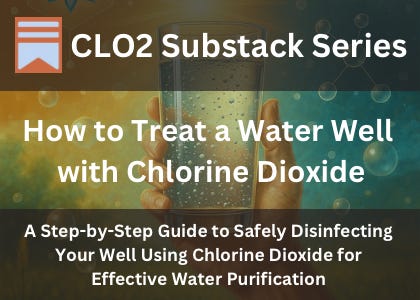How to Treat a Water Well with Chlorine Dioxide
A Step-by-Step Guide to Safely Disinfecting Your Well Using Chlorine Dioxide for Effective Water Purification
Water purification kits containing sodium chlorite and hydrochloric acid (HCl) are to generate chlorine dioxide, a powerful disinfectant, by mixing these two components. This method is commonly used to disinfect water wells and treat water for bacterial contamination.
Important Safety Information
Never mix sodium chlorite and hydrochloric acid directly in an enclosed space.
Only perform the activation in a well-ventilated area, as concentrated chlorine dioxide gas is hazardous to inhale.
Always follow the product’s specific instructions if they differ from those provided below.
Step-by-Step Instructions
Bypass Treatment Systems
Turn off or bypass any water softeners, filters, and reverse osmosis systems connected to your well.
Estimate Well Volume
Determine the volume of water in your well to calculate how much activated solution you will need.
Rough guide: For a 6-inch well casing, there are approximately 1.5 gallons of water per foot.
If uncertain, it is generally safer to use a slightly stronger concentration.
You may use an online calculator, such as the one at hydro-terra.com, to calculate well volume.
3. Prepare the Chlorine Dioxide Solution
Using droppers or a syringe, activate the sodium chlorite solution by mixing it with hydrochloric acid in a clean container (20 drops = 1 mL).
For a typical concentration:
Use 2 drop of each component per liter of water for 10 ppm chlorine dioxide (or 8 drops per gallon in the well).
Mix equal drops of 25-28% sodium chlorite and 4-5% HCl.
Let the mixture stand for 1 minute in a small, covered container until it turns yellowish-brown, then immediately add it to a gallon of water.
Example: If your well contains 134 gallons of water, use 134 gallons × 8 drops = 1072 drops. Since 20 drops = 1 mL, divide: 1072 ÷ 20 = 53.6 mL. Mix 54 mL of sodium chlorite with 54 mL of acid activator.
4. Add the Solution to the Well
Pour the 1 gallon of activated solution directly into the well casing.
If possible, use a hose connected to a faucet fed by the well pump to recirculate water from the well back into the casing for 15–30 minutes. This helps distribute the disinfectant throughout the system.
5. Open All Faucets
Run all taps, showers, and fixtures until you detect the chlorine dioxide odor (or a distinctive chlorine-like scent) at each outlet.
Close all faucets after water with disinfectant has passed through them.
6. Contact Time
Let the solution sit in the entire system (well, piping, tank) for at least 6–12 hours. Overnight contact is ideal to ensure full disinfection.
7. Flush the System
After sufficient contact time, flush the system by running water through an outside faucet (away from plants or streams) until there is no odor.
Continue flushing all indoor and outdoor taps until all disinfectant is removed.
8. Test Water Quality
After 5–7 days, test your water for coliform bacteria and other contaminants to ensure the well is safe to use.
If contamination persists, you may repeat the process at double the dose and then retest.
Additional Information and Precautions
This procedure is typically effective for one-time disinfection following repairs, a new installation, or contamination events.
If well contamination is persistent or recurrent, seek professional analysis and remediation.
Always consult well-specific guidance, your water treatment kit’s instructions, or a water specialist for accurate dosing tailored to your well’s volume and contamination level.
For additional references, please see the sources listed in the previous published article on water purification with chlorine dioxide
Purify Water Anywhere, Anytime
Chlorine dioxide (ClO₂) is a highly safe and effective disinfectant widely recognized for its ability to purify water by killing bacteria, viruses, and even some hardy protozoan parasites such as Giardia and Cryptosporidium. [1,2] Its broad-spectrum efficacy, safety profile, and ease of use make it a preferred choice for travelers, hikers, and emergency…






I use CD to sanitize my produce. After soaking it in 1 tsp baking soda to 2 C water to remove dirt and pesticides, I rinse and then soak it in CD. This makes produce last much longer, especially berries and other types that tend to go bad quickly. I use 20 drops activated in 1/4 cup water, then add that to about 4- 6 cups of rinse water.
Brilliant idea to offer this formula and instructions for homeowners with wells. Huzzah huzzah!